If education freedom were a hockey game, Florida just scored a Texas hat trick.
For the fourth consecutive year, Florida was ranked the No. 1 state for education freedom for K-12 students and families in The Heritage Foundation’s annual Education Freedom Report Card. The 2025 Heritage rankings come after a landmark year of state legislative sessions that delivered wins for students and families.
Florida leaders credited the state’s ranking to policies that give parents control over their children’s education dollars, offering a plethora of choices, including a la carte courses provided by school districts and charter schools.

Florida Gov. Ron DeSantis signs HB 1, which offered families universal eligibility to Florida education choice scholarship programs.
“In Florida, we are committed to ensuring parents have the power to make the education decisions that are best for their child,” said Gov. Ron DeSantis, who in 2023 signed legislation that offered universal eligibility for K-12 state education choice scholarship programs that allow families to direct their dollars toward the best options for their children. “Florida offers a robust array of educational choices, which has solidified our state as a national leader in education freedom, parental power, and overall K-12 education.”
Commissioner of Education Anastasios Kamoutsas said earning the top ranking for four years affirms the state’s long-term commitment to families.
“Under Governor DeSantis’ leadership, Florida will continue honoring parents’ right to choose the best educational option for their child’s individualized needs. I am proud that Florida offers so many educational options that parents can have confidence in.”
Since the Education Freedom Report Card began in 2022, Florida has earned the top ranking every year. The report card uses five categories: school choice, transparency, regulatory freedom, civic education, and spending to rank states.
In addition to Florida receiving the overall top spot for Education Freedom, it also earned high rankings in the following categories:
Earlier this year, the Sunshine State also earned national recognition for putting dollars behind its policies. In January, the national advocacy group EdChoice put Florida first on its list of each state’s spending on education choice programs proportional to total education spending.
 According to the EdChoice report, Florida became the first state to spend more than 10% of its combined private choice and public-school expenditures on its choice programs, rising from an 8% spending share in 2024.
According to the EdChoice report, Florida became the first state to spend more than 10% of its combined private choice and public-school expenditures on its choice programs, rising from an 8% spending share in 2024.
Florida also reached a historic milestone when, for the first time, more than half of all K-12 students were enrolled in an educational choice option. During the 2023–24 school year, 1,794,697 students, out of the state’s approximately 3.5 million K-12 population, used a learning option other than their assigned district school.
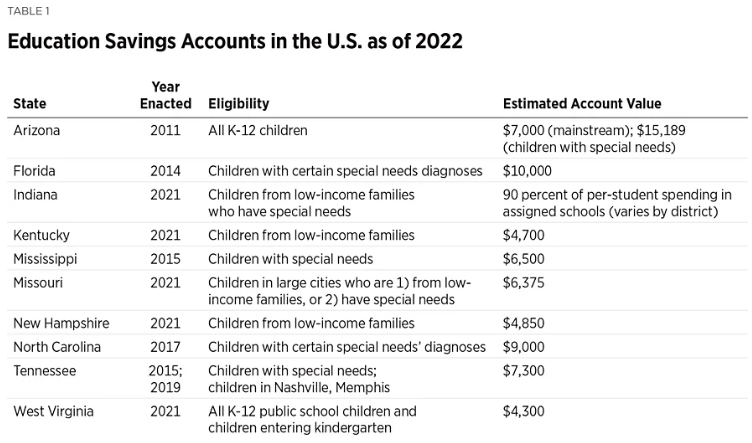 Editor’s note: This report from Jonathan Butcher, Will Skillman Fellow in Education, Center for Education Policy at The Heritage Foundation, and Jason Bedrick, Research Fellow, Center for Education Policy at The Heritage Foundation, concludes that education savings accounts empower parents with the ability to meet every child’s unique education needs and should be available to all school-aged children. It includes a review of changes to education savings account plans around the country, specifically in Arizona, Florida, North Carolina, and Tennessee.
Editor’s note: This report from Jonathan Butcher, Will Skillman Fellow in Education, Center for Education Policy at The Heritage Foundation, and Jason Bedrick, Research Fellow, Center for Education Policy at The Heritage Foundation, concludes that education savings accounts empower parents with the ability to meet every child’s unique education needs and should be available to all school-aged children. It includes a review of changes to education savings account plans around the country, specifically in Arizona, Florida, North Carolina, and Tennessee.
In July 2022, Arizona lawmakers converted the nation’s oldest K–12 education savings account (ESA) policy into the country’s most inclusive learning option: Every child in Arizona can now apply for a private account that empowers families to customize a student’s learning experience according to his or her unique needs.
News Release, “Governor Ducey Signs Most Expansive School Choice Legislation in Recent Memory,” Office of Arizona Governor Doug Ducey, July 7, 2022, https://azgovernor.gov/governor/news/2022/07/governor-ducey-signs-most-expansive-school-choice-legislation-recent-memory (accessed October 12, 2022).
With an ESA, the state deposits a portion of a child’s education spending from the state K–12 formula—the formula used to determine per-student spending in traditional schools—into a private account that parents use to buy education products and services for their children. The accounts are worth approximately $7,000 for mainstream children, with larger amounts awarded to children with special needs.
Families can use an ESA to hire a personal tutor for their child, find an education therapist, pay private school tuition, buy curricula and textbooks, save money from year to year for future expenses, and more. The accounts allow families to choose more than one education product or service; moreover, they provide the versatility parents needed to continue their children’s education during the pandemic when schools were closed to in-person learning.
Jonathan Butcher, “COVID-19 Has Accentuated Value of Education Savings Accounts,” reimaginED, May 12, 2020, https://nextstepsblog.org/2020/05/covid-19-has-accentuated-value-of-education-savings-accounts/ (accessed October 12, 2022).
Arizona lawmakers adopted the nation’s first ESAs for children with special needs in 2011, and nine other states (Florida, Indiana, Kentucky, Mississippi, Missouri, New Hampshire, North Carolina, Tennessee, and West Virginia) subsequently created similar ESA opportunities for eligible students. Each state offers accounts to children who meet different criteria.
After the pandemic, as researchers report steep learning losses across grade levels and subjects, the call for quality learning options is especially urgent. Arizona’s new law is remarkable because all K–12 children can participate.
In Florida and Tennessee, for example, children with certain special needs are eligible, while Mississippi and North Carolina’s accounts operate under strict caps on the number of participating students due to either provisions in state law or annual appropriations. In West Virginia, all children attending public schools or entering kindergarten are eligible, making it the second-most inclusive ESA policy behind Arizona’s.
Research conducted by The Heritage Foundation in 2017 helps to explain the eligibility criteria and other account details for the savings accounts in Arizona, Florida, Mississippi, North Carolina, and Tennessee, but much has changed in the past five years.
Jonathan Butcher, “A Primer on Education Savings Accounts,” Heritage Foundation Backgrounder No. 3245, September 15, 2017, https://www.heritage.org/sites/default/files/2017-09/BG3245.pdf.
The 2017 report also distinguished between the accounts, which allow families to purchase more than one education product or service at the same time, and school vouchers, which parents can only use to pay private school tuition for their children. The accounts also differ from tax-credit scholarship policies, which provide tax credits to individuals or corporations that make charitable donations to nonprofit organizations that in turn award private school scholarships to eligible students.
Jason Bedrick, “Earning Full Credit: A Toolkit for Designing Tax-Credit Scholarship Policies (2022 Edition),” Pioneer Institute, March 30, 2022, https://pioneerinstitute.org/pioneer-research/earning-full-credit-a-toolkit-for-designing-tax-credit-scholarship-policies-2022-edition/ (accessed October 31, 2022).
In this Backgrounder, we will review the changes to education savings account plans around the country, offer an analysis of the new states with ESA laws, and provide policy recommendations for the future of ESAs.
What’s changed?
Nearly all education savings account plans created since Arizona introduced the concept in 2011 have changed eligibility, funding mechanisms, or other significant provisions:
Arizona. Arizona’s accounts were initially only available to children with special needs but expanded to include children assigned to failing schools and children adopted from the state foster care system in 2012.
Butcher, “A Primer on Education Savings Accounts.”
Lawmakers later expanded student eligibility to include children from active-duty military families and children living on tribal lands, among others. In 2022, Arizona opened eligibility to every K–12 student in the state, some 1.1 million school children.
News release, “Governor Ducey Signs Most Expansive School Choice Legislation in Recent Memory.”
When Governor Doug Ducey (R) signed the expansion, 11,775 Arizona students were using the accounts, and after the application period opened in September 2022, the state department of education received about 22,500 new applications from interested families within two months.
Jason Bedrick and Jonathan Butcher, “Arizona Shows the Nation What Education Freedom Looks Like,” Newsweek, September 14, 2022, https://www.newsweek.com/arizona-shows-nation-what-education-freedom-looks-like-opinion-1742145 (accessed October 12, 2022); EdChoice, “Arizona: Empowerment Scholarship Accounts,” https://www.edchoice.org/school-choice/programs/arizona-empowerment-scholarship-accounts/ (accessed October 31, 2022); and Christine Accurso, “Arizona’s New ESA School Choice Law Is a Win for Everyone,” The Washington Examiner, September 9, 2022, https://www.washingtonexaminer.com/restoring-america/community-family/arizonas-new-esa-school-choice-law-is-a-win-for-everyone (accessed October 12, 2022); Eryka Forquer, “Applications for school vouchers at nearly 22,500 so far, Education Department says,” Arizona Republic, October 7, 2022, https://www.azcentral.com/story/news/local/arizona-education/2022/10/07/arizona-school-vouchers-nearly-22-500-applications-pour-so-far/8208504001/ (accessed November 3, 2022).
Florida. In 2014, Florida lawmakers enacted the nation’s second education savings accounts, called Gardiner Scholarships. In 2021, state officials adopted a proposal to combine the program with the state’s K–12 private school scholarship program, called Family Empowerment Scholarships, creating the Family Empowerment Scholarships for Students with Unique Abilities (FES-UA).
Step Up for Students, “Basic Program Facts about the Family Empowerment Scholarship (formerly the Gardiner Scholarship),” https://www.stepupforstudents.org/research-and-reports/gardiner-scholarship/basic-program-facts-gardiner/ (accessed October 12, 2022).
In the 2021–2022 school year, 21,155 children were using accounts.
Step Up for Students, “Family Empowerment Scholarship for Children with Unique Abilities,” August 2022, https://www.stepupforstudents.org/wp-content/uploads/2022.8.10-FES-UA-ESA.pdf (accessed October 12, 2022).
North Carolina. North Carolina lawmakers enacted Personal Education Savings Accounts in 2017, but in the 2022–2023 school year, these accounts will merge with the state’s K–12 private school scholarships for children with special needs (Disability Grants).
North Carolina State Education Assistance Authority, “Education Student Accounts (ESA+) Program,” https://www.ncseaa.edu/k12/esa/ (accessed October 12, 2022).
Account holders will still be able to purchase more than one education product or service, a feature of the accounts in every state with such a program. Some students with special needs may be eligible for accounts worth up to $17,000 (an increase from the original account award of $9,000).
Account holders can also participate in the Disability Grant program and the state’s Opportunity Scholarships, which are K–12 private school scholarships for children from low-income families. As of March 2022, 658 students were using an account.
North Carolina Education Assistance Authority, “Education Savings Account Summary of Data,” March 16, 2022, https://www.ncseaa.edu/education-savings-account-summary-of-data/ (accessed October 12, 2022).
Tennessee. Tennessee lawmakers allowed children with certain special needs to access accounts in 2015. (The program officially launched in 2017.)
Tennessee General Assembly, 2015 Session, S.B. 27, https://wapp.capitol.tn.gov/apps/BillInfo/Default.aspx?BillNumber=SB0027 (accessed October 31, 2022).
In the 2020–2021 school year, 307 students were using the accounts.
EdChoice, “Tennessee: Individualized Education Account Program,” https://www.edchoice.org/school-choice/programs/tennessee-individualized-education-account-program/ (accessed October 12, 2022).
In 2019, lawmakers adopted another ESA proposal, with these accounts available to children in Nashville and Memphis (Shelby County). School district officials sued to force children to remain in assigned schools, but in June 2022, the state supreme court ruled that the program could begin operation in the coming school year. In August, the Chancery Court for Davidson County rejected more motions that would have stalled the program.
Conor Beck, “Court Victory for Parents Defending Tennessee’s Educational Savings Account Program,” Institute for Justice, August 5, 2022, https://ij.org/press-release/court-victory-for-parents-defending-tennessees-educational-savings-account-program/ (accessed October 12, 2022).
New state laws
In 2021, lawmakers in five states adopted new education savings account plans, including two that combined tax-credit scholarships with education savings accounts:
West Virginia. West Virginia lawmakers adopted a proposal that made nearly every child in the state eligible to apply for an account, making it the most expansive account any state officials had approved at that time, and the second-most expansive after Arizona’s universal expansion in 2022.
West Virginia Legislature, 2021 Regular Session, HB 2013, https://www.wvlegislature.gov/Bill_Status/bills_history.cfm?INPUT=2013&year=2021&sessiontype=RS (accessed October 31, 2022).
All students attending a public school in West Virginia for at least 45 days or who are entering kindergarten are eligible to apply for the accounts, aptly named Hope Scholarships.
Lawmakers require students to attend a public school for 45 days because by that time in the school year the student is included in the traditional school funding formula for that year. Then, if the student uses an education savings account, the taxpayer money from the public school formula “follows” the child to an education savings account and no new taxpayer money is needed. If a child was in a private school or homeschooled, new taxpayer money would need to be added to the state treasury to fund that child’s account. If students are required to attend a public school before using an account, the education savings account program will not generate a fiscal note stating that new taxpayer money is required for students to use the accounts.
Similar to the accounts in Arizona, state officials deposit a child’s portion of the state school spending formula into a private account that parents can use to buy multiple products and services.
Each account will be worth approximately $4,300, according to the Cardinal Institute, a research institute in West Virginia.
Cardinal Institute, “Questions from Parents,” https://www.cardinalinstitute.com/questions-from-parents/ (accessed October 12, 2022).
Parents can use the accounts for personal tutors and education therapies, along with private school tuition and private online learning programs.
Implementation of the ESA policy was delayed because education industry special interest groups supported a lawsuit to force account holders back into assigned public schools. The state supreme court of appeals agreed to consider the case, and on October 6, 2022, the court upheld the program, removing an injunction that had prevented families from using the accounts.
Brad McElhinny, “Supreme Court Takes Over Hope Scholarship Appeal, Promises Hearing Soon, Says No to Stay,” MetroNews, August 18, 2022, https://wvmetronews.com/2022/08/18/supreme-court-takes-over-hope-scholarship-appeal-promises-hearing-soon-says-no-to-stay/#:~:text=Hearing%20a%20challenge%20to%20the,from%20the%20public%20education%20system (accessed October 12, 2022), and Amanda Kieffer, “Press Release: Cardinal Institute Celebrates Historic Win for West Virginia Families,” Cardinal Institute, October 6, 2022, https://www.cardinalinstitute.com/press-release/wvscoa-upholds-hope-scholarship/ (accessed October 31, 2022).
The program is now fully operational.
Conor Beck, “Victory for School Choice in West Virginia,” Institute for Justice, October 6, 2022, https://ij.org/press-release/victory-for-school-choice-in-west-virginia/ (accessed October 31, 2022).
Indiana. Indiana lawmakers adopted an account proposal that allows children with special needs from low- and middle-income families (i.e., household incomes of up to 300 percent of the income eligibility guidelines for the federal free- or reduced-priced lunch program).
Indiana General Assembly, 2021 Session, HB 1001, https://iga.in.gov/legislative/2021/bills/house/1001#document-dbc2cc8e (accessed October 31, 2022).
Students do not have to attend a public school before applying for an account.
State officials limited funding for the accounts so that only 2,000 students can participate in 2022.
EdChoice, “Indiana: Education Scholarship Account Program,” https://www.edchoice.org/school-choice/programs/education-scholarship-account-program/ (accessed October 31, 2022).
New Hampshire. In New Hampshire, officials adopted Education Freedom Accounts in 2021. The accounts are available to students from households with incomes at or below 300 percent of the federal poverty line ($83,250 for a family of four in 2022–2023).
New Hampshire General Court, 2021 Session, HB 2, https://gencourt.state.nh.us/bill_status/legacy/bs2016/bill_status.aspx?lsr=1082&sy=2021&sortoption=&txtsessionyear=2021&txtbillnumber=HB2 (accessed October 31, 2022).
The accounts are administered by a K–12 private school scholarship organization, Children’s Scholarship Fund NH.
Education Freedom Coalition, Education Freedom NH, https://educationfreedomnh.org/ (accessed October 12, 2022).
In its first year of operation (the 2021–2022 school year), nearly 2,000 children used accounts. That amounts to more than 1 percent of K–12 students in the Granite State—a record enrollment, per capita, for the first year of operation of any education choice policy. Each account was worth approximately $3,400. As of September 2022, more than 3,025 students are receiving ESAs worth an average of $4,857.
Children’s Scholarship Fund New Hampshire, “Frequently Asked Questions,” https://1b2.ee8.myftpupload.com/wp-content/uploads/2022/03/NH-FAQ-2.28.22.pdf (accessed October 12, 2022); Ethan Dewitt, “Education Freedom Accounts Double after One Year; Most Recipients outside Public School,” New Hampshire Bulletin, September 15, 2022, https://newhampshirebulletin.com/briefs/education-freedom-accounts-double-after-one-year-most-recipients-outside-public-school/ (accessed October 12, 2022).
Kentucky. Bluegrass State lawmakers created accounts funded by charitable donations to nonprofit, scholarship-granting organizations.
In Kentucky the new ESA Policy allows students to choose from a variety of education products and services in addition to private school tuition.
Kentucky Legislature, 2021 Session, HB 563, https://apps.legislature.ky.gov/record/21rs/hb563.html (accessed October 31, 2022).
Eligible students include children in households with incomes of up to 175 percent of the income limit for the federal free- or reduced-priced lunch program.
The program has restrictive features not found in other states’ account offerings, though. One such feature prevents participants from receiving account funding if his or her household income increases to a figure greater than 250 percent of the income limit for free- or reduced-priced lunch.
EdChoice, “Kentucky: Education Opportunity Account Program,” https://www.edchoice.org/school-choice/programs/education-opportunity-account-program/ (accessed October 12, 2022).
Another provision states that only students living in large counties (with populations greater than 90,000) can use their accounts for private school tuition.
Lawmakers have not implemented Kentucky’s program yet due to a lawsuit challenging the accounts.
Kentucky Department of Revenue, “Education Opportunity Account Program,” October 12, 2021, https://revenue.ky.gov/News/Pages/Education-Opportunity-Account-Program.aspx (accessed October 31, 2022).
Missouri. Lawmakers in Missouri, as in Kentucky, adopted an education savings account program that is funded via charitable contributions to scholarship-granting organizations.
101st Missouri General Assembly, 1st Regular Session, HB 349, https://house.mo.gov/Bill.aspx?bill=HB349&year=2021&code=R (accessed October 31, 2022).
Individuals will receive tax credits of up to 100 percent of their donations but the amount of credits claimed by any donor cannot exceed half of their annual state tax liability. Only 10 scholarship organizations are allowed to award accounts.
Cameron Gerber, “Parson Signs New ESA Program into Law,” The Missouri Times, September 7, 2022, https://themissouritimes.com/parson-signs-new-esa-program-into-law/ (accessed October 12, 2022).
Lawmakers limited the total amount of tax credits awarded to contributors to $25 million in the program’s first year.
Research
Since lawmakers’ adoption of the first account program in Arizona in 2011, research has demonstrated that account holders use their ESAs for more than private school tuition. The versatility of the accounts, which distinguishes them from K–12 private school vouchers, has allowed families to meet their children’s unique needs.
This distinction is important because in states with constitutional provisions that restrict the use of public spending on private learning options (known as “Blaine” amendments), parents’ ability to choose more than one learning option has allowed the accounts to survive judicial scrutiny in state courts that are hostile to traditional vouchers.
Parents’ ability to use ESAs for several education products and services at the same time is crucial for providing quality learning experiences outside the classroom.
In 2013 and 2016, researchers found that approximately one-third of Arizona account holders used their child’s ESA for more than one education product or service.
Lindsey M. Burke, “The Education Debit Card: What Arizona Parents Purchase with Education Savings Accounts,” EdChoice, August 2013, https://www.edchoice.org/wp-content/uploads/2013/08/2013-8-Education-Debit-Card-WEB-NEW.pdf (accessed October 12, 2022), and Jonathan Butcher and Lindsey M. Burke, “The Education Debit Card II: What Arizona Parents Purchase with Education Savings Accounts,” EdChoice, February 2016, https://www.edchoice.org/wp-content/uploads/2016/02/2016-2-The-Education-Debit-Card-II-WEB-1.pdf (accessed October 12, 2022).
Again, parents’ access to textbooks, personal tutors, education therapists, online classes, and more is what makes the accounts unique among private learning options in states around the country.
In 2018, researchers found that more than one-third of account holders in Florida also used the ESAs for more than one purpose. This report also found that among these families purchasing more than one product or service, more than half (55 percent) paid for several products and services and did not purchase private school tuition—making them “customizers” of their children’s educations apart from private schools.
Lindsey Burke and Jason Bedrick, “Personalizing Education: How Florida Families Use Education Savings Accounts,” EdChoice, February 2018, https://www.edchoice.org/wp-content/uploads/2018/02/Personalizing-Education-By-Lindsey-Burke-and-Jason-Bedrick.pdf (accessed October 12, 2022).
More recent studies continue to substantiate these findings that separate the accounts from traditional K–12 scholarships. In 2021, a study of North Carolina account holders found, for the first time, that a majority of account holders used their child’s ESA for more than one product or service. Sixty-four percent of account holders used their child’s ESA to select more than one education item or service.
Jonathan Butcher, “A Culture of Personalized Learning,” John Locke Foundation, August 13, 2021, https://www.johnlocke.org/research/a-culture-of-personalized-learning/ (accessed October 12, 2022).
This figure is nearly double the share of families using the accounts in this way in the first two studies of ESA usage in Arizona.
This report also found that families using the accounts lived in ZIP codes where the average income was close to the statewide median. Fifty-three percent of account holders—more than half—live in areas in which the median income is within $10,000 of the statewide median. These findings mean that students from families of modest means are benefitting from the ESAs.
According to the report, families using private school scholarships at the same time as they participated in the state’s education savings account options in North Carolina also purchased more than one item or service. In North Carolina, families can access an education savings account and a K–12 private school scholarship option for children with special needs or from low-income families.
Even families that accessed an account and a scholarship used the new opportunities to pay for more than private school tuition, providing evidence that when the accounts are offered to families in addition to scholarships or vouchers, parents will still make education purchases according to a child’s needs.
A 2021 study analyzing Florida account holder spending found that parents continue to customize a child’s education when they remain with an ESA for longer periods. According to researchers Michelle L. Lofton and Marty Lueken, “The longer students remain in the program, the share of ESA funds devoted to private school tuition decreases while expenditure shares increase for curriculum, instruction, tutoring, and specialized services.”
Michelle L. Lofton and Martin F. Lueken, “Distribution of Education Savings Accounts Usage Among Families: Evidence from the Florida Gardner Program,” Brown University EdWorkingPaper No. 21-426, June 2021, https://www.edworkingpapers.com/sites/default/files/ai21-426.pdf (accessed October 12, 2022).
The percent of Florida ESA funds that parents used each school year increased from 60 percent in 2015 to 73 percent in 2016 to 88 percent in 2019. During this same period, however, the amount of account funds spent on education products outside of tuition (“instructional materials”) quadrupled. Here again, research demonstrates that parents will customize a child’s learning experience when they have the opportunity to purchase different services and items, and education savings accounts are meaningfully different from K–12 private school vouchers.
Policy recommendations
Eligibility. Lawmakers should give every child in their state the option to use an education savings account—and Members of Congress should do the same for K–12 students in Washington, DC, students living within federal jurisdictions, such as tribal lands and attending Bureau of Indian Education (BIE) schools, and children in active-duty military families.
Limiting account access creates a multi-tiered education system where certain families have more and better learning opportunities for their children than others. Furthermore, research on student achievement after the pandemic demonstrate that millions of children are not performing at age- or grade-appropriate levels and need help gaining essential life and academic skills.
Nation’s Report Card, “Reading and Mathematics Scores Decline During COVID-19 Pandemic,” 2022, https://www.nationsreportcard.gov/highlights/ltt/2022/ (accessed October 12, 2022).
Lawmakers should act with a sense of urgency to help students catch up.
Funding. State officials should transfer a child’s portion of the state education spending formula into a private account that parents use to purchase education products and services. This method is preferable to plans that fund the accounts through annual appropriations, which are subject to legislative spending constraints each year and can require additional taxpayer spending.
Policymakers can follow the models in place in Arizona and now Florida, to name just two, that allow taxpayer spending to follow a child to their public or private learning choices.
Testing. State officials should allow participating private schools to choose the national norm referenced test—such as the Stanford series, the Iowa Test of Basic Skills, or the Classical Learning Test (CLT)—that best matches the institution’s curriculum and report aggregate results after a period of three years. The agency administering the accounts should contract with a survey company to measure parent satisfaction.
These two indicators—aggregate student results over time and parent satisfaction—should serve as the measures of success for account holders. Test results, though, should not determine student or school eligibility for participation in an account program.
Lawmakers should not require account holders to take state tests administered to public school students because such assessments impact instructional choices, thus affecting school officials’ curricular decisions and limiting parental options. Requiring account holders, homeschool students, or private school students to take state tests would produce uniformity, not an account option that allows for customization according to a child’s unique needs.
Conclusion
Every child should have the opportunity to succeed in school and in life. After the pandemic, as researchers report steep learning losses across grade levels and subjects, the call for quality learning options is especially urgent.
National Center for Education Statistics, “Reading and Mathematics Scores Decline During COVID-19 Pandemic,” NAEP Long-Term Trend Assessment Results: Reading and Mathematics, https://www.nationsreportcard.gov/highlights/ltt/2022/ (accessed October 31, 2022), and Clare Halloran, Rebecca Jack, James C. Okun and Emily Oster, “Pandemic Schooling Mode and Student Test Scores: Evidence from U.S. States,” National Bureau of Economic Research, November 2021, https://www.nber.org/papers/w29497 (accessed October 31, 2022).
Education savings accounts empower parents with the ability to meet every family and child’s unique education needs and should be available to all school-aged children. Students need options such as ESAs now more than ever.

Hope, Caleb and Mary Hayes attend school on Florida's Family Empowerment Scholarship for Students with Unique Abilities.
Editor’s note: This commentary from Jonathan Butcher, Will Skillman Fellow in Education at the Heritage Foundation and a reimaginED guest blogger, and Jason Bedrick, a research fellow at the Heritage Foundation’s Center for Education Policy, appeared Saturday on orlandosentinel.com. You can listen to reimaginED senior writer Lisa Buie’s podcast with Emily Hayes here.
As a mother of five children, Emily Hayes knows that every child has different needs. And she is keenly aware that these needs change over time.
This means life at home must change as children grow and, so does life at school — or wherever a child is learning.
This is a lot for any parent to handle. Especially parents of children with special needs.
As a mom living in Port St. Lucie, though, Emily had access to K-12 education savings accounts — formerly known as Gardner Scholarships and now called Family Empowerment Scholarships for Students with Unique Abilities (FES-UA).
These flexible scholarship accounts allowed Emily to choose different education products and resources at the same time for her children, from textbooks to personal tutors and beyond.
The accounts “have the flexibility to change with the kid,” Emily says, which has allowed her and her husband to specifically meet each of their children’s needs with personal tutors and therapy services and in recent years, a private school. “Each of [my children] has so many different needs. And it changes year-to-year as they progress year to year,” she says.
Two of her children are on the autism spectrum; another has complications related to brain and spinal development.
Emily’s children are among the 25,000 Florida students using these accounts. Another 84,000 are using vouchers to attend K-12 private schools, and 80,000 more attend private schools using scholarships funded by charitable contributions to scholarship-granting organizations, such as Step Up for Students.
With the breadth and depth of Florida’s private education landscape, the state is ranked first in a new Heritage Foundation survey of all 50 states and Washington, D.C., in the areas of education choice, academic transparency, low regulations on schools, and a high return on investment for taxpayer spending on education. In three of the four categories examined Florida ranks among the top three nationwide.
For education choice, Florida ranks third behind Arizona and Indiana. All three states offer families numerous pathways to choose the learning environment that works best for their children. Studies find that education choice policies lead to higher levels of achievement and educational attainment as well as greater civic participation and tolerance, and lower levels of crime.
But for parents to choose well, they need information. That’s where the Sunshine State truly shines, earning first place for academic transparency. Earlier this year, Gov. Ron DeSantis signed a bill that allows parents to see a list of materials that teachers are using in classrooms and view the catalogue of school library books. State officials also approved a proposal saying teachers and students must be free to engage in debates in class, but no one can be compelled to believe ideas, such as the idea that — because of their skin color — individuals deserve blame for past actions committed by others.
The high degree of transparency enables parents to hold schools accountable directly. Instead of trying to ensure quality through top-down regulations and red tape, Florida relies on bottom-up accountability, which is why it ranks second in the nation for regulatory freedom.
Schools and teachers have a high degree of freedom to operate as they see fit, within the boundaries set by age-appropriateness and civil rights laws, and parents provide accountability through their freedom to choose the schools that work best for their kids.
Florida lawmakers’ embrace of choice, transparency and regulatory freedom has produced one of the highest returns on investment in the nation, ranking seventh nationwide. While keeping spending within reason, Florida has steadily improved its performance on the National Assessment for Education Progress over the past two decades, rising to 17th nationwide in its combined fourth-grade and eighth-grade math and reading scores.
As for Emily, she says that “the kids are thriving.” The school aligns with her family’s values and has provided “targeted therapy” for each child — a winning combination.
But it took more than a single assigned school to help her and her children find success.
“Not every school is going to meet the needs of every kid,” Emily says, which makes education choice essential.
If an assigned school anywhere in the country is not meeting a child’s needs, parents should point to Florida and ask their lawmakers, “Why can’t we have more options, too?”

A 2010 march in Tallahassee drew nearly 6,000 advocates in support of parental choice. Their voices have grown stronger over the past 12 years.
Months ago, The Heritage Foundation published a study showing that Democrats have provided determinative votes only rarely in state legislatures on private choice programs. I’ve seen little publicly that would constitute a substantive response.
Privately, I’ve heard multiple missives that fall somewhere on the “random grousing” to “grasping at straws” to “pulling hair out and mumbling whacky sassafras” spectrum.
I suggest that we simply confess the emperor’s nudity: The swing votes in legislative choice battles have strongly tended to be located in the moderate/rural side of the Republican caucus. If you convince them, you tend to win. If you don’t, you tend to lose.
While I could name a large number of heroic counter examples, these constitute exceptions rather than the rule. This most important question is not whether this has been the case, but rather how it should inform action moving forward.
My suggestion: Choice advocates should recognize that legislative Democrats are unlikely sources for swing votes but continue to recruit constituencies for choice across all communities.
Polls show strong bipartisan support for choice, but this has been the case for decades. Unions recruiting primary opponents, knocking on doors, and making campaign contributions can have quite a deterrent effect from translating these polls into legislative action.
We have indeed seen nearly successful, and in fact successful, choice efforts in deep blue states like New York and Illinois, respectively. The movement, however, seems disturbingly incurious about emulating the strategies and tactics of those efforts.
It’s a pity that those nearly successful and successful efforts in deep blue states deserve study and emulation. The New York and Illinois efforts went heavy on coalition building and included a number f constituencies that traditionally align with Democrats.
It isn’t easy to pull off. It is difficult work.
A couple of years ago, exit polls showed that a threat to choice programs in the Florida governor’s race helped tip the outcome. As Bill Mattox, director of the Marshall Center for Educational Options at the James Madison Institute, concluded in a commentary published recently in the Wall Street Journal:
Most of all, Florida’s surprising outcome ought to encourage every American—especially in these hyperpolarized times—to support policies that bring together strange bedfellows to solve serious problems.
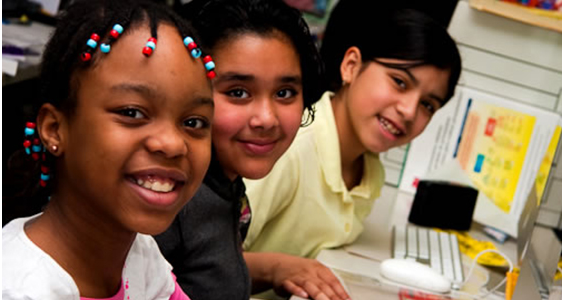
District of Columbia Public Schools operates 117 schools, serving more than 51,000 students.
Editor’s note: This commentary from Jonathan Butcher, Will Skillman fellow in education policy at The Heritage Foundation and a reimaginED guest blogger, appeared Wednesday in the Washington Times.
A wide performance gap between white students and black students has persisted in D.C. public schools for generations. Lawmakers can help close this gap today, and at the same time, erase any remaining vestiges of a problem created by their brethren decades ago.
The gap should also be called an “opportunity” gap, not just a performance gap, and federal officials must be part of the solution in the District.
The nation’s capital is one of many urban areas for which federal bureaucrats drew “red lines” on maps in the early 20th century, denoting less-desirable places to live. The federal Home Owners Loan Corporation and Federal Housing Administration based these decisions on poverty levels and, yes, racial makeup.
(This was during President Franklin Roosevelt’s New Deal, an era when racial segregation still plagued American life.) Real estate developers, bankers and HOLC would not build in redlined areas or lend to families who moved there.
Americans have resoundingly rejected segregation both legally and culturally since then, and America is not systemically racist today. But the effects of redlining still affect families’ education opportunities.
At the FHA, it was more than an article of faith; it was a policy that neighborhoods would be undesirable destinations for homebuyers if their schools drew students from disadvantaged backgrounds, a concept that contained more than a hint of racial prejudice. The FHA’s underwriting manual from 1938 explicitly stated that if students from low-income homes are concentrated in certain schools, “the neighborhood under consideration will prove far less stable and desirable.”
Jude Schwalbach’s report for The Heritage Foundation explains that the similarity between the FHA’s map from the 1930s that ranked District neighborhoods and the boundaries of failing public schools is unmistakable — and sad.
To continue reading, click here.
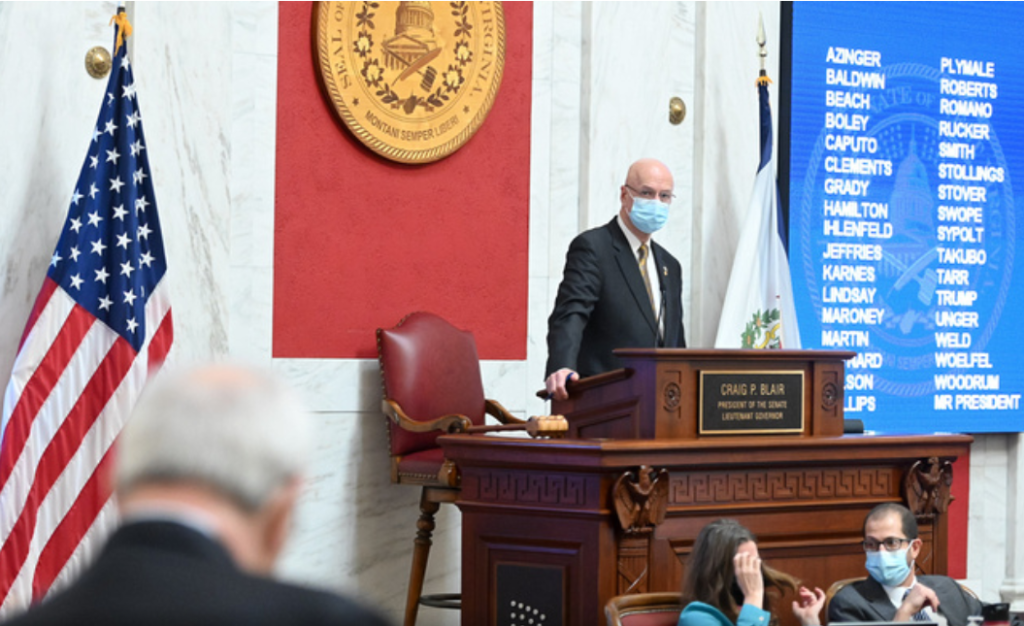
West Virginia is among a cavalcade of states that are creating additional educational opportunities for families this legislative session.
Editor’s note: This commentary from Lindsey Burke, director of the Center for Education Policy at The Heritage Foundation and a redefinED contributor, appears on The Heritage Foundation’s website.
School districts are slowly beginning to reopen in-person instruction after being closed for nearly a year – or, in many places, for over a year. While this is a wonderful development, it will never erase what parents experienced last year: uncertainty, inconsistency, and, in some cases, ineptitude from public schools.
The events of the last year have demonstrated to many families that public schools are not always the reliable institutions many thought they were. It also opened their eyes to just how powerful the teachers unions are, and revealed what many already suspected: that their modus operandiis not to support teachers who want to teach but to score political wins.
Thankfully, in response to these disappointments, multiple state legislatures are undertaking one of the biggest expansions of school choice in history. Here are some states to watch:
West Virginia
On March 29, West Virginia Gov. Jim Justice signed into law the most expansive school choice program in the country, a nearly universal option for education savings accounts.
This is monumental. It is the nation’s first universal education savings account program open to all children in the state. Students who choose to participate in the education savings account option will receive 100% of what the state would have spent on their education in their prior public school—or approximately $4,600 per year—which they can then use to pay for private school tuition, online learning, private tutoring, and a variety of other education services, products, and providers.
To continue reading, click here.
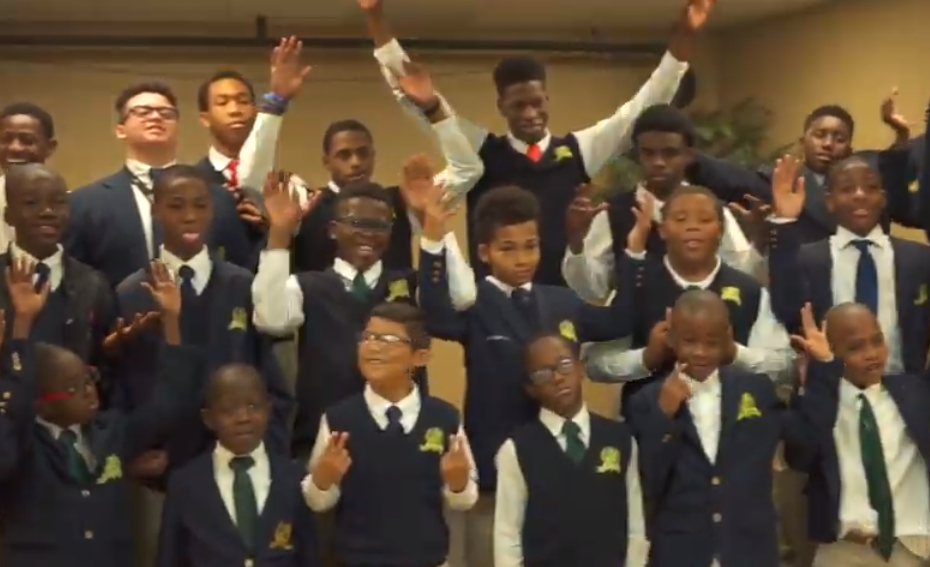
Launched in 2013, Piney Grove Boys Academy in Fort Lauderdale is one of roughly 2,000 private schools that participate in Florida’s array of choice scholarship programs, including the Florida Tax Credit Scholarship.
The enrollment of more than 100,000 participants in the Florida Tax Credit Scholarship program for the 2020-21 academic year garnered the No. 2 spot on the Heritage Foundation’s list of this year’s most important education choice stories.
The year-in-review piece points out that 100,008 Florida students were enrolled in the tax credit scholarship program according to the Florida Department of Education, making it the first school choice program to move beyond the 100,000 mark.
Even as the coronavirus pandemic presented new challenges for students and families, the foundation praised policymakers and families for responding quickly with innovative solutions that helped advance education choice.
You can view other stories on the foundation’s “best of” list at https://www.heritage.org/education/commentary/8-education-choice-wins-2020.
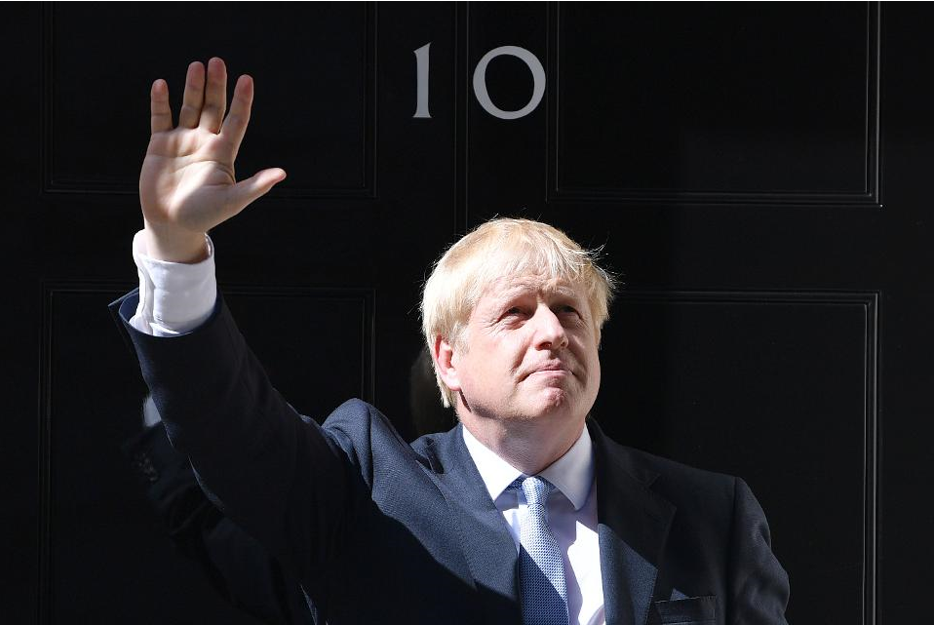
Boris Johnson returned to Downing Street with a large majority after Conservatives swept Labour aside in its biggest majority at Westminster since Margaret Thatcher's 1987 election victory.
Lindsey Burke, director of the Center for Education Policy at the Heritage Foundation, Nile Gardiner, who directs the Foundation’s Margaret Thatcher Center for Freedom, and your humble author teamed up recently to produce a report calling for a next generation assisted places program in the United Kingdom.
redefinED readers may recall my December 2019 post explaining that the British Labour Party campaigned during the General Election on a platform that included a proposal for the state to close private schools and seize their assets. Supporters of this proposal justified the illiberal position based on the notion that private schools are excessively exclusive.
Private schools in Britain did in fact become more exclusive than they otherwise would have been after a Labour government eliminated in 1997 a program known as the Assisted Places Scheme, which helped low-income students attend private schools. Labour suffered one of the greatest electoral disasters in modern British history, creating the opportunity for the Conservative government to address the issue of private school exclusivity in a constructive fashion:
Any future choice program should include and advantage the poor but must have broader community support in order to survive. In order to achieve the goal of Assisted Places – bringing economic diversity to British private schools – such choice options must be made widely available to all families, broadening community participation and support.
A subtle but profound shift could accomplish these goals and more. The main focus for the United Kingdom should be on funding students. The technology now exists to allow families to control their education funding to allow them to choose between a variety of school and non-school educational experiences. Rather than simply funding schools, Britain should be funding educations.
The death of the Assisted Places Scheme instructs current reformers to think in bolder strokes. Britain’s hyper-majoritarian political system, once described as “an elected dictatorship” means that communities of interest must be broad and strong in order to last. A well-constructed education savings account program can not only increase the economic diversity of private schools, but also can open a universe of non-school service providers such as therapists and tutors.
One of the major political parties went on record in full totalitarian mode regarding private schools. British private schools should not only support public policies to reduce exclusivity, but also should develop a wider coalition in civil society to meet the threat to their liberty and continued existence.